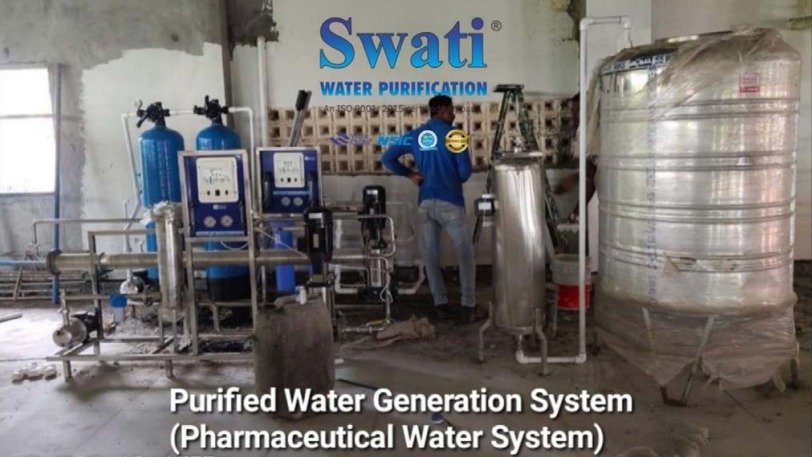Pharmaceutical Water treatment System
Swati Water Purification – Pharmaceutical Water treatment System Supplier, Pharmaceutical Water treatment System Manufacturer.

Pharmaceutical Water treatment System
A Pharmaceutical Water treatment System is designed to Produce Clean, Safe and Potable Water from Various Water Sources (Such as Groundwater, Surface Water or Even Seawater) by Removing Impurities, Contaminants and Harmful Microorganisms. These Systems Use a Combination of Different Filtration, Treatment and Disinfection Processes To Ensure the Water Meets Health and Safety Standards.
A Pharmaceutical Water Treatment System is designed to Produce High-Purity Water that Meets the Strict Quality and Safety Requirements for Use in Pharmaceutical Manufacturing. These Systems are Essential for Ensuring that Water Used in the Production of Drugs, biologics, vaccines and Other Pharmaceutical Products Meets Regulatory Standards for Purity, Sterility and Consistency.
Purified Water generation System & Pharmaceutical Water System Manufacturer
Purified Water Generation Systems In Pharmaceutical Industry as Well as in Other Sectors Requiring High Quality Water, Can go by Various Names Depending on the Specific Function, Technology Used and Industry Application. Here are Some Common Names For These Systems: “Reverse Osmosis (RO) System,” “RO System,” “RO Water Purification System,” “RO Water Treatment System,” “Pharmaceutical Water System,” “Purified Water (PW) System,” “PW Generation System,” “Ultraviolet (UV) Sterilization System,” “UV Water Purification System,” “Mixed Bed Ion-Exchange System,” “Mixed Bed System,” “High Purity Water System,” “High Purity Water generation System,” “Pharmaceutical Water treatment System,” “Centralized Water Purification System,” “Ultra-Pure Water (UPW) System,” “Ultra-Pure Water generation System.”
Pharmaceutical Water Systems Often Reflect the Type and Quality of Water they produce, as well as the Technology Used. Here are Some Common Names of Pharmaceutical Water Systems: “Purified Water (PW) System,” “Purified Water Generation System,” “Highly Purified Water (HPW) System,” “Highly Purified Water Generation System,” “High Purity Water System,” “Reverse Osmosis (RO) System,” “Reverse Osmosis Pharmaceutical System,” “Reverse Osmosis Water Treatment System,” “UV Water Purification System,” “Mixed Bed Ion Exchange System,” “Mixed Bed System,” “Centralized Pharmaceutical Water System,” “Ultra-Pure Water System,” “Pharmaceutical Water Treatment Plant,” “Purified Water Distribution System.”
Capacities Of Purified Water Generation System & Pharmaceutical Water Treatment System:
1. Medium-Scale Systems (Mid-Sized Pharmaceutical Or Biotechnology Plants)
- Capacity Range: 100 lph to 1,000 lph
- Applications: Medium-Sized Pharmaceutical Manufacturing Plants, Biotechnology Labs, Food and Beverage Production and Research Institutions.
2. Large-Scale Systems (Large Pharmaceutical and Biotech Manufacturing Plants)
- Capacity Range: 1000 lph to 10,000 lph
- Applications: Large Pharmaceutical manufacturing, Biopharmaceutical Production, vaccine Manufacturing and Large Food and Beverage Processing Plants.
3. Industrial-Scale Systems (High-Demand Manufacturing and Multi-Facility Operation)
- Capacity Range: 10,000 lph to 100,000 lph
- Applications: Large Pharmaceutical Production Facilities, Biopharmaceutical Companies, Large Food and Beverage Manufacturers and Multinational Research Campuses.
4. Very Large Systems (Pharmaceutical Plants, Biotech Factories and Utilities)
- Capacity Range: 100,000 lph to 1,000,000 lph
- Applications: Massive Pharmaceutical Plants, Industrial Biotech Operations, Utilities for Municipal Or Multiple Facility Water Supply and Large Medical Centers with High Water Usage.
Purified Water Generation System & Pharmaceutical Water Treatment System Stages:
1. Pre-Treatment Of Raw Water:
- Coarse Filtration: Removes Larger Particles like Sand, Silt and Debris from the Raw Water Supply.
- Activated Carbon Filtration: Removes Chlorine, Organics and Some Other Contaminants that can affect the Taste, Odor and Quality of the Water.
- Water Softening: Softens Water by removing Hardness-Causing Minerals (like Calcium and Magnesium) to Prevent Scaling in Downstream Equipment.
2. Main Purification:
- Reverse Osmosis (RO): RO Is a Key Technology In Both Systems. It Uses a SemiPermeable Membrane to remove Dissolved Solids (TDS), Salts and Organic Contaminants.
- Ultraviolet (UV) Disinfection: UV Treatment is Often Used as a Final Disinfection Step, Particularly for Water Used in Critical Pharmaceutical Processes.
3. Storage and Distribution:
- Storage Tanks: Both Systems’ Water is Typically Stored in Tanks Made from Materials that are Resistant to Contamination and Microbial Growth. These Tanks are designed for Minimal Contamination and Typically Feature Continuous Circulation to Prevent Stagnation.
- Distribution System: The Purified Water is distributed to the Pharmaceutical Production area through a Piping System. This System Should be Designed With Smooth Surfaces to Avoid Microbial Growth and it may be Equipped with Temperature Controls and Continuous Circulation to Maintain Water Quality.
